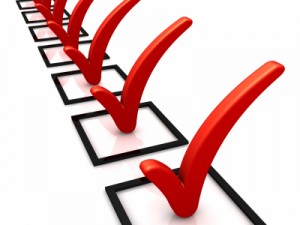A Proofreading Checklist for Flawless Documents
 Most experts advise writers against attempting to proofread their own work. Generally, proofreading should be performed by a fresh set of eyes in order to get the best results. Authors are less likely to recognize and identify their own mistakes and may allow glaring errors to pass unchallenged; however, for those who wish to proofread their own work, a detailed proofreading checklist of necessary steps will prove helpful.
Most experts advise writers against attempting to proofread their own work. Generally, proofreading should be performed by a fresh set of eyes in order to get the best results. Authors are less likely to recognize and identify their own mistakes and may allow glaring errors to pass unchallenged; however, for those who wish to proofread their own work, a detailed proofreading checklist of necessary steps will prove helpful.
The First Time Through
The first item on the proofreading checklist is spelling. Depending on the format of the material, the initial spell check will likely be performed by a word processing program. This should not be used as a substitute for going over the document word-by-word. It is advisable to print out the document if this is feasible, since printed materials are easier to read and errors are less likely to escape notice. Pay special attention to commonly misspelled words and words that are often confused for each other including principle/principal and there/their/they’re; when in doubt, consult a dictionary to ensure proper usage.
Unsure if you’re catching all of your errors? We can help. Simply contact us to learn how we can help ensure your documents are flawless.
Go Over It Again
The next step on a comprehensive proofreading checklist is reviewing grammar and punctuation. This includes subject/verb agreement, proper capitalization, incomplete or run-on sentences, repeated or omitted words, punctuation and style issues. Professional proofreaders generally adhere to a specific style manual in order to ensure consistency throughout the proofreading process. Some popular style guides include The Chicago Manual of Style, The Elements of Style by Strunk and White, The MLA Style Manual and The Associated Press Stylebook. These helpful guides typically include commonly misspelled words, rules for capitalization, underlining and italicization. While most style issues should be addressed during the editing process, proofreaders are tasked with checking this aspect of the document as well and should strive to adhere to a single consistent style throughout the work.
Sound It Out
Reading the document out loud can help proofreaders identify potential issues with subject/verb agreement, unclear antecedents, sentence fragments and run-on sentences. During each of the proofreading checklist steps, it is likely that additional spelling and punctuation errors will be spotted as well. While simple grammatical errors should be corrected immediately, larger contextual or structural problems are generally a problem of editing and may require a rewrite during the editing process; they are not generally addressed during the proofreading stage.
A good rule of thumb is to proofread the document using the entire proofreading checklist until no errors of any kind are found on two consecutive passes. This can be a time-consuming process, but will produce a solid, professional piece of work that makes the best possible impression on readers. In order to avoid missing errors, which is a common problem when proofreading your own work, and to save time, it is advisable to hire a professional proofreading service.




